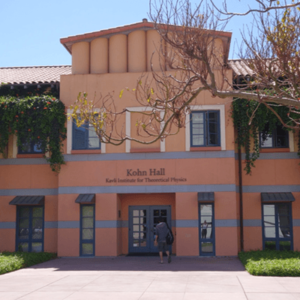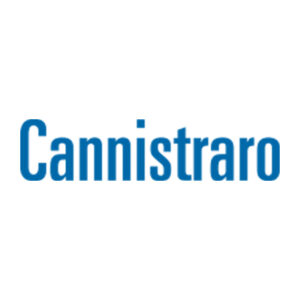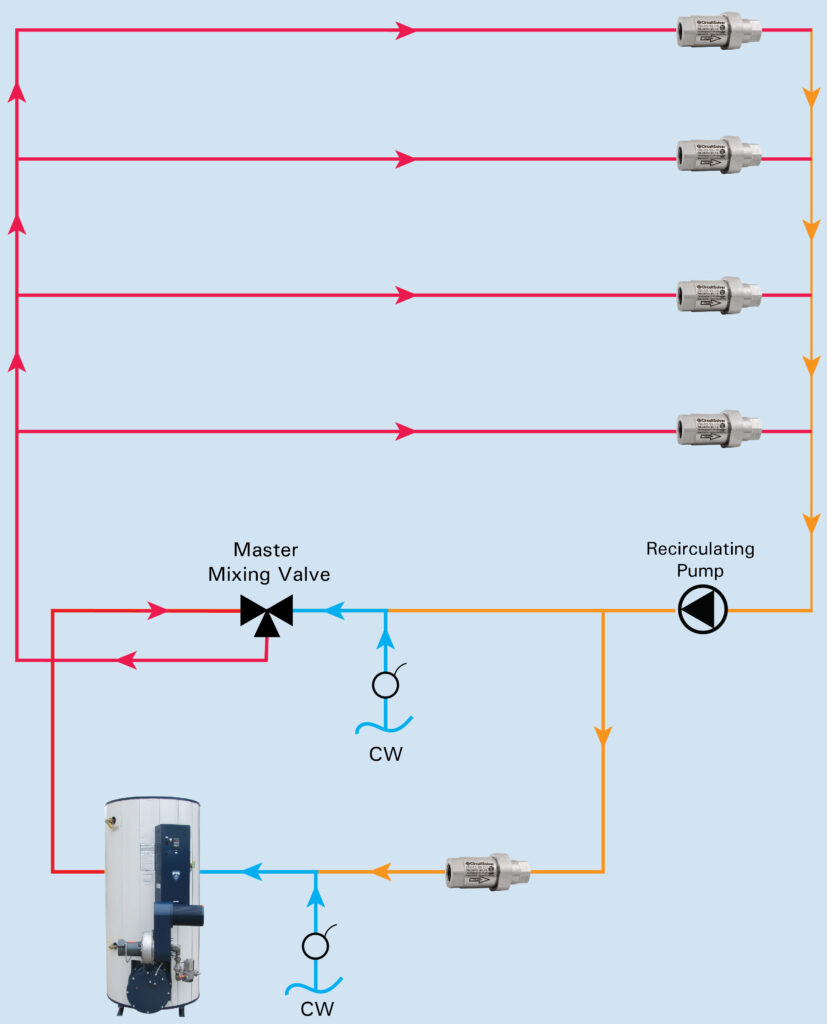How CircuitSolver Valves Work
Traditional manual balancing valves often fall short of meeting the dynamic hot water needs of domestic hot water recirculation systems. Manual balancing is typically achieved by combining several contractors’ efforts to repeatedly balance and re-balance the system to achieve the required flow in a static environment during start-up. This balancing process results in hefty labor costs and frequent callbacks as the dynamics of system usage render the initial balancing inadequate.
While manual balancing methods are suitable in theory, they flounder in practice; inflated labor costs and the inability to react to dynamic changes in the Domestic Hot Water System (DHWS) highlight these inefficiencies.
Thermostatic Balancing – Install it and Forget it!
To conquer the challenges inherent to traditional manual balancing methods, ThermOmegaTech® invented CircuitSolver®, the market’s first thermostatic balancing valve.
CircuitSolver® automatically balances a Domestic Hot Water System (DHWS) by modulating flow to maintain a set water temperature at the end of each supply branch or riser, eliminating the need for manual balancing while ensuring instant hot water delivery to each fixture.
Using our patented Thermoloid® blended paraffin wax actuator, CircuitSolver® continuously monitors the water temperature and automatically adjusts flow as conditions change to send hot water where needed to accommodate demand variations.
Installed in-line at the end of each branch or riser before the return, the CircuitSolver® utilizes a thermal actuator to modulate the valve open and closed* in response to temperature variations to control water flow to the return.
When the water temperature falls below the valve’s set-point, the CircuitSolver® modulates open to allow more water to flow. As the water approaches the valve’s set-point temperature again, the CircuitSolver® automatically modulates towards its closed* position.
*Note: The valve will never fully close, allowing a small flow bypass to the return to avoid dead-heading the recirculation pump.
Download Brochure
A Temperature Solution to a Temperature Problem
During the initial start-up of a Domestic Hot Water System (DHWS), this modulation will allow additional flow to the branches still in need of hot water, ensuring a thermally balanced system. Each valve operates independently during post-startup operation, establishing flow as needed to meet the system’s variable hot water demands throughout the day. Your system is initially balanced in hours, not days, and stays balanced even as conditions change.
CircuitSolver® thermostatic balancing valves can also balance the return flow between the master mixing valve and the water heater. Go to the Balancing a DHWS Return with CircuitSolver page to learn more about this application.
Have Questions?
Ready to Buy?
Benefits:
- Industry-leading 3-year warranty
- Constructed entirely of stainless steel
- Ensures hot water is rapidly delivered to all faucets
- Eliminates manual balancing
- Eliminates the need to oversize recirculation pumps
- Minimizes velocity induced erosion of pipes, valves & fittings
- Reduces installation and maintenance costs
- Promotes effective water conservation
Certifications:
- All Components are NSF/ANSI/CAN 61 or NSF 372 Certified
- Lead Free
- Massachusetts Board of Approval
- Compliant with Section 1417(d) of SDWA, the Safe Drinking Water Act
- Complies with Section 116875 of the California Health & Safety Code
- Supports efforts toward LEED Certification
- Complies with the Buy American Act
Discover how CircuitSolver® will significantly improve the performance, savings, and durability of your building’s domestic hot water system. To learn more about CircuitSolver® and its application in your projects, please get in touch with our team of plumbing product experts.

I try to have CircuitSolver® specified on as many jobs as possible due to the simplicity of it. Eric McTee Plumbing Designer at ME Engineering in Golden, CO

CircuitSolver® was able to automatically balance the system when engineers could not. Mark Wilmink MarkCo Plumbing in Florence, KY

CircuitSolver® is a game changer in balancing DHWS and I would definitely use it as a standard in future projects. Matt Trevino Plumbing Engineer at DBR Engineering in San Antonio, TX

USC Villages Student Housing - By using CircuitSolver®valves, we saved time and money by not having to balance the system or make any adjustments. It made the process much easier and smoother. Richard Parker Plumbing Contractor at Pan-Pacific Mechanical in Fountain Valley, CA

The Da Vinci Project - By using CircuitSolver® balancing valves, we were able to save both time and money. The start-up process was much faster by not having to manually adjust each valve. After installation, the system balanced itself and required no maintenance. Arturo Hernandez GJM Engineering in Los Angeles, CA

CircuitSolver® makes the initial startup so easy. When we turned it on, the valves balanced the whole system without us having to make any adjustments. We never have any issues when installing them in our projects. Plumbing Contractor Production Plus Plumbing in Vista, CA

Simply stated, CircuitSolver® valves are easy to install and work very well with no issues to date. They’re efficient and take the time typically required to manually balance systems at the end of the project out of the equation. Christopher Meurer Plumbing Operations Manager at J.C. Cannistraro, LLC in Boston, MA

CircuitSolver® makes balancing the system so easy. We don’t have to manually set each line or make any adjustments. We have had absolutely no balancing issues since we started up the system. Richard Parker Plumbing Contractor at Pan-Pacific Mechanical in Fountain Valley, CA

CircuitSolver® is a great product - I have never used anything like it. Robert Schrieber Maintenance Manager at Embassy Suites in Brunswick, GA

What an awesome little device these guys make. It’s a no-brainer. Andy Crossland Principal Mechanical Engineer at Crossland Engineering LLC in Honolulu, HI

It was taking over a minute and a half to get hot water, and now it’s down to 15-20 seconds…also a huge conservation of water…it was a fairly simply retrofit. Robert Albanese Owners Representative for The Austonian in Austin, TX

CircuitSolver® is a great product - I have never used anything like it. Robert Schrieber Maintenance Manager at Embassy Suites in Brunswick, GA

CircuitSolver® is a great product. The valves automatically adjust to changing temperatures and pressure drops unlike manual and automatic balancing valves. Plumbing Contractor Production Plus Plumbing in Vista, CA

We’ve used CircuitSolver®s exclusively now for several years in every application we can. Simply stated, the product is easy to install and works very well with no issues to date. Christopher Meurer Plumbing Operations Manager at J.C. Cannistraro, LLC in Boston, MA

By eliminating the conventional method of using fixed flow balancing valves and installing CircuitSolver® valves instead we were able to resolve our lack of hot water in some sectors of the hospital issue instantly. André Renaud Building Consultant at Mental Health University Institute of Quebec

When we install CircuitSolver® valves, it corrects the client’s hot water circulation problems, and everything operates as it’s designed. We are going to keep installing them. Jason Putnam Project Manager at Douglas ORR Plumbing in Miami Springs, FL

CircuitSolver®, being that it is an automatic balancing valve, just makes the job of balancing an intricate hot water system that much easier. David Texter Plumbing Engineer at Browne Engineering in Cincinnati, OH

Using CircuitSolver® makes balancing the system so easy. The valves automatically adjust themselves, so you don’t have to check each valve once installed, and there are never any callbacks for issues. Arturo Hernandez GJM Engineering in Los Angeles, CA

Rittenhouse Hill Apartments - We had a very complicated apartment restoration involving 47 risers. CircuitSolver® saved a lot of time, installed easily, used smaller recirculation pumps to save energy & wear, and continues performing well. Ron Miller President at Adelphia Plumbing in Philadelphia, PA

The advantages of the system are an efficiently balanced system, saving time testing and balancing the system, lower utility bills and reduced water usage. Luke Holding Project Engineer at The Beck Group in Dallas, TX

Right after the installation the general manager went around the building and there was a noticeable difference with quick delivery of hot water. Andy Crossland Principal Mechanical Engineer at Crossland Engineering LLC in Honolulu, HI

CircuitSolver® valves are efficient and take the time typically required to manually balance systems at the end of the project out of the equation. We have started up systems in the afternoon to come in the next morning to find hot water perfectly balanced throughout all risers and zones. Christopher Meurer Plumbing Operations Manager at J.C. Cannistraro, LLC in Boston, MA

I haven’t come across another product like CircuitSolver®. Once you install the valves you never have to adjust them, unlike manual balancing valves where you have to balance every single valve you install. Richard Parker Plumbing Contractor at Pan-Pacific Mechanical in Fountain Valley, CA

Before CircuitSolver®, we would have wait times between 5-7 minutes for hot water on the higher floors. Since we have installed CircuitSolver® valves, we are getting hot water when we need it and have not had a single complaint. Robert Schrieber Maintenance Manager at Embassy Suites in Brunswick, GA

I would tell any contractor, building engineer, and mechanical engineer if you are looking at CircuitSolver®, it is simple, it is easy to use, and it works right from the get-go. Chris Watts Plumbing Service Manager at Braconier in Denver, CO

It usually takes 2-3 plumbers, 2-3 days to balance a system of this size, but by using CircuitSolver® this process was done instantly. Huge savings in terms of time and effort typically devoted to the balancing process. Stephan Thompson Plumbing Contractor at E.M. Duggan Inc. in Canton, MA
The University of South Florida - On startup of this install, the system automatically balanced itself in under 3 hours, all without manual labor thanks to CircuitSolver®. The plumbers actually went out a did another job, went to breakfast, and when they came back, the system was balanced. Mike Bishop V.P. of Engineering at RGD Consulting Engineers in Jupiter, FL

